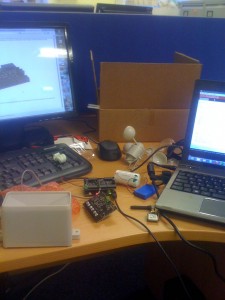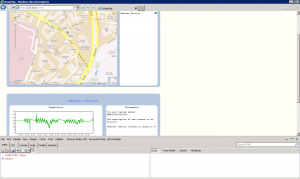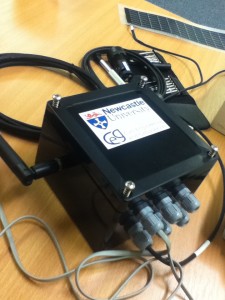In order to establish a long term urban research facility Newcastle University is looking to bring together new and existing data that includes the urban climate, air quality, pedestrian and traffic flows as well as hydraulic flows. These new data sources will come from a number of sources, one of which will be a system of new sensors set-up around Newcastle. The particular sensors that are going to be used are waspmotes developed by Libelium, sensor devices specially oriented to developers. They work with different protocols (ZigBee, Bluetooth and GPRS) as well as a variety of frequencies (2.4GHz, 868MHz and 900MHz). More than 50 sensors can be connected with these devices with the measurements and frequency configured manually. The sensors can take a number of readings such as the concentration of different gases, temperature, liquid level, weight, pressure, humidity, luminosity, accelerometer, soil moisture and solar radiation.
Thus, as part of my role as a research assistant on this project I was sent along to a training course learning how to write the code to configure these devices. The training course took place in Zaragoza, Spain at Libelium HQ.
It consisted of 4 days of demonstrations and exercises getting familiar with the equipment and how to use them. These ranged from getting the waspmote to send “hello world” to a gateway (a USB device that receives messages and prints them to the screen) all the way through to sensing nearby Bluetooth devices then sending these to a database. We were also taught “clever” uses of the sensors like using the internal accelerometer to detect whether the device had fallen or was being stolen (attach a GPS and a SIM card and you can get it to text you the thief’s location!).
At the end of the training course we were shown their next generation of sensors; the Plug and Sense. These require very little development work as the devices come already mounted in a box and the user just has to attach the relevant sensor probe and then use the code generator to set the recordings taken and frequency at which they are taken.
Since returning I have started to develop a weather station using a waspmote, an agriculture board and weather sensors such as a rain gauge, an anemometer and a temperature gauge.

Despite initial setbacks, like recording monsoon like conditions whilst inside, I was able to get it set up and feeding into a postgres database. From this, I set-up a simple webmap using the database along with django to display the location of the sensor and the data feed.

The aim is now to develop more sensors and deploy these in more meaningful places (not everybody just wants to know the temperature in my office) around the University campus and wider city.

Neil

I was wondering where to get these https://blogs.ncl.ac.uk/geospatialengineering/files/2013/02/Neils-weather-proof-box.jpg enclosures?
Thanks.
Guy
Hi Guy,
The devices we are using for this research come from libelium (http://www.libelium.com/) as a complete unit with ability to then attach a range of sensors to each unit as required.
Hope this is useful,
Craig
Hi Craig,
Thanks for the info.
We also are using both plug & sense and waspmote oem for our iot projects. For the waspmote oem we are searching an enclosure.
Guy
Hello!
I was wondering if you’re still working with these sensors and if you’re satisfied with quality of the data they generate?
cheers, Willemijn